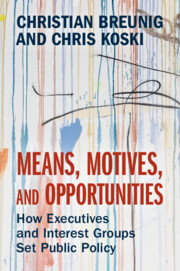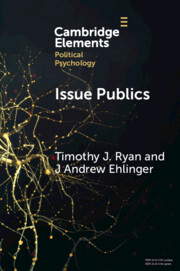123 results
Revolving doors in Europe: does hiring from the public sector facilitate access?
-
- Journal:
- Journal of Public Policy , First View
- Published online by Cambridge University Press:
- 04 June 2024, pp. 1-18
-
- Article
-
- You have access
- Open access
- HTML
- Export citation
CHORUS: A New Dataset of State Interest Group Policy Positions in the United States
-
- Journal:
- State Politics & Policy Quarterly ,
- Published online by Cambridge University Press:
- 17 May 2024, pp. 1-26
-
- Article
-
- You have access
- Open access
- HTML
- Export citation
Information, politicization, and reputation: assessing interest groups’ agenda-setting influence in the EU
-
- Journal:
- European Political Science Review , First View
- Published online by Cambridge University Press:
- 14 February 2024, pp. 1-18
-
- Article
-
- You have access
- Open access
- HTML
- Export citation
1 - Explaining One Million Policy Stories
-
- Book:
- Means, Motives, and Opportunities
- Published online:
- 11 April 2024
- Print publication:
- 08 February 2024, pp 3-24
-
- Chapter
- Export citation
4 - Opportunities
-
- Book:
- Means, Motives, and Opportunities
- Published online:
- 11 April 2024
- Print publication:
- 08 February 2024, pp 110-141
-
- Chapter
- Export citation
2 - Meeting at the Margins
-
- Book:
- Means, Motives, and Opportunities
- Published online:
- 11 April 2024
- Print publication:
- 08 February 2024, pp 25-66
-
- Chapter
- Export citation

Means, Motives, and Opportunities
- How Executives and Interest Groups Set Public Policy
-
- Published online:
- 11 April 2024
- Print publication:
- 08 February 2024
8 - Dogonomics
-
- Book:
- Dog Economics
- Published online:
- 11 January 2024
- Print publication:
- 01 February 2024, pp 175-188
-
- Chapter
- Export citation
The population ecology of interest groups and counter-mobilization: reproductive rights organizations in the United States, 1920–1985
-
- Journal:
- Political Science Research and Methods , First View
- Published online by Cambridge University Press:
- 19 January 2024, pp. 1-10
-
- Article
-
- You have access
- Open access
- HTML
- Export citation
Empires, Languages, and Scripts in the Perso-Indian World
-
- Journal:
- Comparative Studies in Society and History / Volume 66 / Issue 2 / April 2024
- Published online by Cambridge University Press:
- 11 January 2024, pp. 443-469
-
- Article
-
- You have access
- Open access
- HTML
- Export citation
Canada's Lobbying Industry: Business and Public Interest Advocacy from Harper to Trudeau
-
- Journal:
- Canadian Journal of Political Science/Revue canadienne de science politique / Volume 56 / Issue 4 / December 2023
- Published online by Cambridge University Press:
- 02 January 2024, pp. 975-998
-
- Article
-
- You have access
- Open access
- HTML
- Export citation
5 - Coalition Building
-
- Book:
- Strategy Beyond Markets
- Published online:
- 02 November 2023
- Print publication:
- 16 November 2023, pp 49-65
-
- Chapter
- Export citation
Sociopolitical reputation and the reform of pharmacies in Greece and Portugal
-
- Journal:
- Journal of Public Policy / Volume 44 / Issue 1 / March 2024
- Published online by Cambridge University Press:
- 15 November 2023, pp. 185-207
-
- Article
- Export citation
The representative capacity of interest groups: explaining how issue features shape membership involvement when establishing policy positions
-
- Journal:
- Journal of Public Policy / Volume 43 / Issue 4 / December 2023
- Published online by Cambridge University Press:
- 14 September 2023, pp. 791-811
-
- Article
-
- You have access
- Open access
- HTML
- Export citation
The Macro-Political Context and Interest Groups' Access to Policymakers
-
- Journal:
- Government and Opposition , First View
- Published online by Cambridge University Press:
- 26 June 2023, pp. 1-26
-
- Article
-
- You have access
- Open access
- HTML
- Export citation
Affluence, congruence, and lobbying success in EU climate policy
-
- Journal:
- Journal of Public Policy / Volume 43 / Issue 3 / September 2023
- Published online by Cambridge University Press:
- 30 May 2023, pp. 512-532
-
- Article
-
- You have access
- Open access
- HTML
- Export citation
Change of government and interest groups' preference attainment on the formulation of the Italian National Recovery and Resilience Plan (NRRP): from Conte to Draghi
-
- Journal:
- Italian Political Science Review / Rivista Italiana di Scienza Politica / Volume 53 / Issue 3 / November 2023
- Published online by Cambridge University Press:
- 10 May 2023, pp. 333-350
- Print publication:
- November 2023
-
- Article
-
- You have access
- Open access
- HTML
- Export citation
6 - Interest Groups and Interest Representation
- from Part II - Key Actors in EU Politics: Citizens, Interest Groups and Political Parties
-
- Book:
- The Politics of the European Union
- Published online:
- 30 March 2023
- Print publication:
- 20 April 2023, pp 119-140
-
- Chapter
- Export citation

Issue Publics
- How Electoral Constituencies Hide in Plain Sight
-
- Published online:
- 10 April 2023
- Print publication:
- 11 May 2023
-
- Element
- Export citation
5 - Groups, Parties, and Policy Demands in House Nominations
- from Part I - Candidate Evaluation and Selection
-
- Book:
- Accountability Reconsidered
- Published online:
- 09 February 2023
- Print publication:
- 16 February 2023, pp 89-126
-
- Chapter
- Export citation



